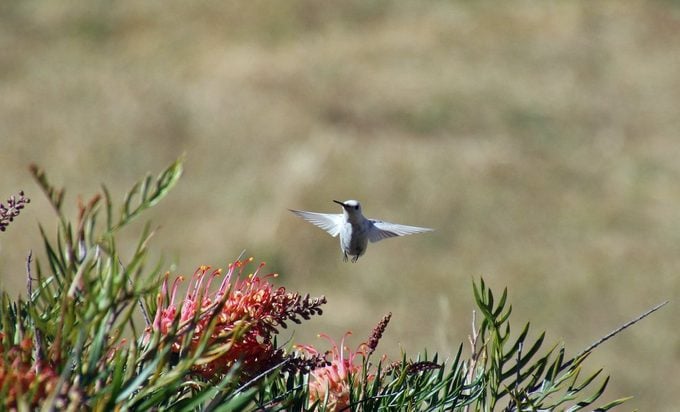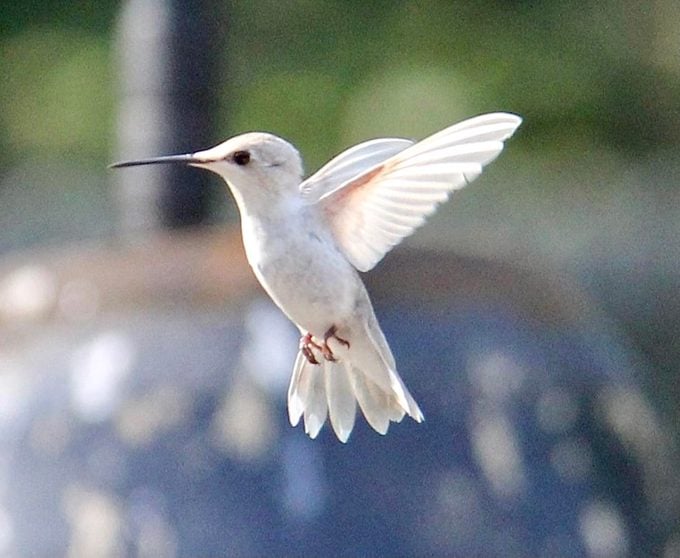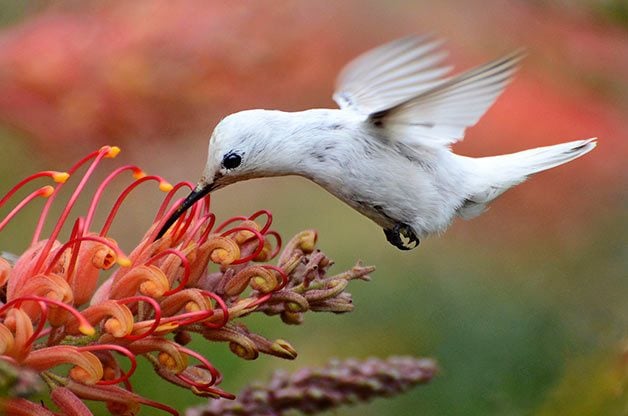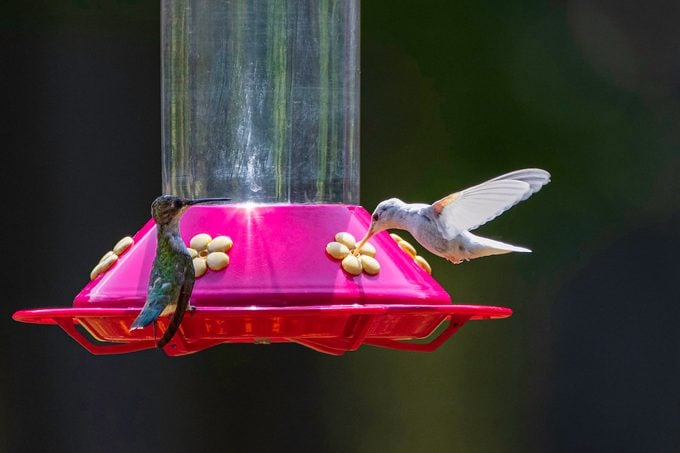Are White Hummingbird Sightings Rare?
Updated: Jun. 24, 2024
What gives a white hummingbird unique plumage? Learn the factors behind white hummingbird feathers and if albino hummingbirds are rare.
On This Page
Why Does a White Hummingbird Have White Feathers?

Seeing a hummingbird of any color is cause for joy. They zip through flowers and amuse birders endlessly with their energy, all while shimmering like gemstones in the golden sunlight. A white hummingbird, however, is a truly memorable sighting.
White hummingbirds aren’t a species of their own—but depending on their specific condition, they can be either leucistic (partly or patchy white, with some color in feathers) or albino (completely white, with red or pink eyes). The factors contributing to the bird’s unusual coloration are complex.

Dr. Kevin McGowan of Cornell Lab of Ornithology Bird Academy explains the biological basics in human terms: “The analogy I like to use is that it’s like starting your car,” he says. “You get in your car and try to start it, but it doesn’t start. Why? Well, there are dozens of different reasons why that could be, but the end result is that the car doesn’t go.”
What scientists do know, he says, is that a white hummingbird’s snowy feathers likely boil down to genetics, development, or diet. In the end, though, scientists are often stumped. “You look at a white hummingbird, and it can be hard to tell exactly why,” Kevin says. “We know it has something to do with the development and deposition of pigments through the body.”
Difference Between Albino and Leucistic Hummingbirds

“This unusual ruby-throated hummingbird (above) graced our yard with its presence three days in a row! Is it leucistic or albino?” asks Birds & Blooms reader Susan Boyce of Pickett, Wisconsin.
Birding experts Kenn and Kimberly Kaufman say, “It’s a rare treat to see one of these white sprites, but the cause of the phenomenon can be hard to judge. Albinism is a mutation in which the bird is unable to produce the pigment melanin, which makes most of the darker colors. Leucism, on the other hand, usually refers to a failure to deposit pigment in the feathers; leucistic birds may be very pale, all white or a patchwork of white and normal coloring.
The hummingbird in your photos has pale gray in the tail where a normal female ruby-throat would have black, suggesting that this bird is leucistic, not a true albino.”
The Impact of White Hummingbird Feathers

Birders might be awestruck at the sight of a white hummingbird, but other hummingbirds? Not so much.
Kevin explains that for females, have light-colored feathers might mean being more susceptible to predation or to nest predation. For males, without a bright gorget, it can mean struggling to find a mate.
“For hummingbirds, it’s all about the male display,” he explains. “If you don’t have the costumes, and the lights, and you don’t have the flashy colors, then you’d better be a good dancer.”
Whether or not a hummingbird passes its all-white coloration down to offspring depends on the source of the coloring in the first place. “If there’s a genetic defect for failure to make melanin, that can be passed down,” Kevin says. “Developmental ways are not genetic, so the answer is yes and no depending on what the problem is.”
White feathers might put the birds at a disadvantage in ways beyond finding mates and avoiding being eaten. Kevin notes that feather structure and support is is dependent on melanin, which white hummingbirds lack. As a result, their feathers might take more wear than those of regularly colored hummingbirds.
What makes hummingbird feathers so shimmery?
How Rare Are Albino Hummingbirds?

Birds & Blooms reader David Jones of Muskogee, Oklahoma, shared this photo (above) of an albino hummingbird that came to visit his feeder. He asked, “How rare are birds like this?”
Birding experts Kenn and Kimberly Kaufman reply, “Every year there are a few reports of hummingbirds that are partly or mostly white. These birds lack most of the melanin and other pigments in their feathers and are called leucistic.
But the bird in your photo appears to have the characteristics of a true albino hummingbird: completely white feathers, pink bill and feet, and even pink eyes. Such true albino hummingbirds are extremely rare. What a treat to have this exceptional and beautiful white hummingbird visiting your feeders.”
Check out more stunning hummingbird photos you need to see.
Why Trust Us
For nearly 30 years, Birds & Blooms, a Trusted Media Brand, has been inspiring readers to have a lifelong love of birding, gardening and nature. We are the #1 bird and garden magazine in North America and a trusted online resource for over 15 million outdoor enthusiasts annually. Our library of thousands of informative articles and how-tos has been written by trusted journalists and fact-checked by bird and garden experts for accuracy. In addition to our staff of experienced gardeners and bird-watchers, we hire individuals who have years of education and hands-on experience with birding, bird feeding, gardening, butterflies, bugs and more. Learn more about Birds & Blooms, our field editor program, and our submission guidelines.
About the Experts
Lifelong birder and ornithologist Dr. Kevin McGowan is a senior course developer for the Cornell Lab of Ornithology’s Bird Academy. He earned a Ph.D in biology at the University of South Florida.
Kenn and Kimberly Kaufman are the official bird experts for Birds & Blooms. They are the creators of the Kaufman Field Guide series and they lead birding trips all over the world.




















